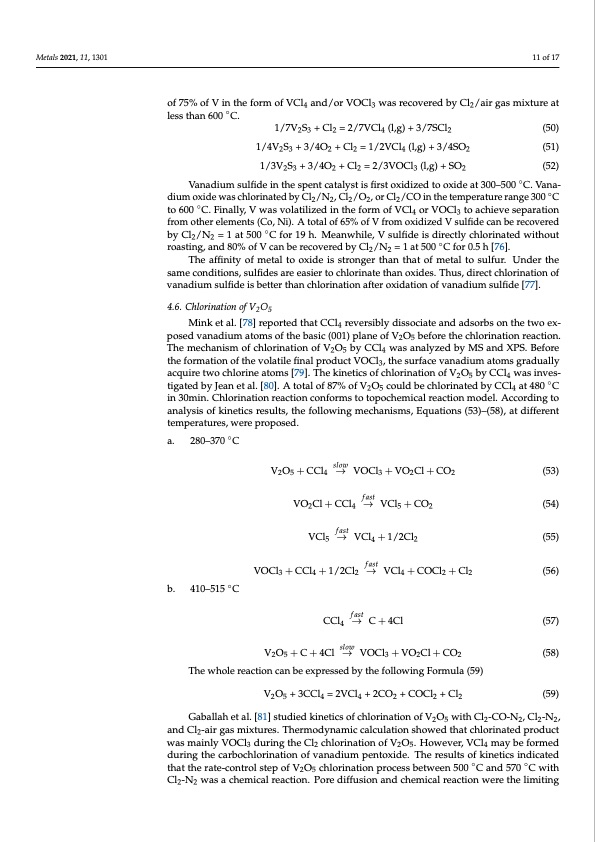
PDF Publication Title:
Text from PDF Page: 011
Metals 2021, 11, 1301 11 of 17 of 75% of V in the form of VCl4 and/or VOCl3 was recovered by Cl2/air gas mixture at less than 600 ◦C. 1/7V2S3 + Cl2 = 2/7VCl4 (l,g) + 3/7SCl2 (50) 1/4V2S3 + 3/4O2 + Cl2 = 1/2VCl4 (l,g) + 3/4SO2 (51) 1/3V2S3 + 3/4O2 + Cl2 = 2/3VOCl3 (l,g) + SO2 (52) Vanadium sulfide in the spent catalyst is first oxidized to oxide at 300–500 ◦C. Vana- dium oxide was chlorinated by Cl2/N2, Cl2/O2, or Cl2/CO in the temperature range 300 ◦C to 600 ◦C. Finally, V was volatilized in the form of VCl4 or VOCl3 to achieve separation from other elements (Co, Ni). A total of 65% of V from oxidized V sulfide can be recovered by Cl2/N2 = 1 at 500 ◦C for 19 h. Meanwhile, V sulfide is directly chlorinated without roasting, and 80% of V can be recovered by Cl2/N2 = 1 at 500 ◦C for 0.5 h [76]. The affinity of metal to oxide is stronger than that of metal to sulfur. Under the same conditions, sulfides are easier to chlorinate than oxides. Thus, direct chlorination of vanadium sulfide is better than chlorination after oxidation of vanadium sulfide [77]. 4.6. Chlorination of V2O5 Mink et al. [78] reported that CCl4 reversibly dissociate and adsorbs on the two ex- posed vanadium atoms of the basic (001) plane of V2O5 before the chlorination reaction. The mechanism of chlorination of V2O5 by CCl4 was analyzed by MS and XPS. Before the formation of the volatile final product VOCl3, the surface vanadium atoms gradually acquire two chlorine atoms [79]. The kinetics of chlorination of V2O5 by CCl4 was inves- tigated by Jean et al. [80]. A total of 87% of V2O5 could be chlorinated by CCl4 at 480 ◦C in 30min. Chlorination reaction conforms to topochemical reaction model. According to analysis of kinetics results, the following mechanisms, Equations (53)–(58), at different temperatures, were proposed. a. 280–370 ◦C b. 410–515 ◦C V2O5 + 3CCl4 = 2VCl4 + 2CO2 + COCl2 + Cl2 (59) slow V2O5 + CCl4 → VOCl3 + VO2Cl + CO2 (53) f ast VO2Cl + CCl4 → VCl5 + CO2 (54) f ast VCl5 → VCl4 + 1/2Cl2 (55) f ast VOCl3 + CCl4 + 1/2Cl2 → VCl4 + COCl2 + Cl2 (56) f ast CCl4 → C+4Cl (57) slow V2O5 +C+4Cl → VOCl3 +VO2Cl+CO2 (58) The whole reaction can be expressed by the following Formula (59) Gaballah et al. [81] studied kinetics of chlorination of V2O5 with Cl2-CO-N2, Cl2-N2, and Cl2-air gas mixtures. Thermodynamic calculation showed that chlorinated product was mainly VOCl3 during the Cl2 chlorination of V2O5. However, VCl4 may be formed during the carbochlorination of vanadium pentoxide. The results of kinetics indicated that the rate-control step of V2O5 chlorination process between 500 ◦C and 570 ◦C with Cl2-N2 was a chemical reaction. Pore diffusion and chemical reaction were the limitingPDF Image | Extraction of the Rare Element Vanadium

PDF Search Title:
Extraction of the Rare Element VanadiumOriginal File Name Searched:
metals-11-01301.pdfDIY PDF Search: Google It | Yahoo | Bing
Product and Development Focus for Salgenx
Redox Flow Battery Technology: With the advent of the new USA tax credits for producing and selling batteries ($35/kW) we are focussing on a simple flow battery using shipping containers as the modular electrolyte storage units with tax credits up to $140,000 per system. Our main focus is on the salt battery. This battery can be used for both thermal and electrical storage applications. We call it the Cogeneration Battery or Cogen Battery. One project is converting salt (brine) based water conditioners to simultaneously produce power. In addition, there are many opportunities to extract Lithium from brine (salt lakes, groundwater, and producer water).Salt water or brine are huge sources for lithium. Most of the worlds lithium is acquired from a brine source. It's even in seawater in a low concentration. Brine is also a byproduct of huge powerplants, which can now use that as an electrolyte and a huge flow battery (which allows storage at the source).We welcome any business and equipment inquiries, as well as licensing our flow battery manufacturing.| CONTACT TEL: 608-238-6001 Email: greg@salgenx.com | RSS | AMP |